How to Teach Your Kids the Basics of Chess
Hi everyone,
We have here a nice article by Kenney (Ken) Myers who is very active in the care industry which includes childcare, senior care, pet care, and other types of in-home care services. In addition to running multiple websites and businesses in this industry, he also participates in various coalitions and organizational boards. Ken loves writing articles on helping kids learning on new subjects.
We share one nice article from Ken's blog: How to Teach Your Kids the Basics of Chess
--------------------------------------
Moms and dads who enjoy the game of chess are often anxious to teach it to their offspring. It is a wonderful bonding experience, and makes for fond memories and family traditions. A child will look back tenderly on his Sunday afternoon chess matches with Mom or Dad. Other parents are not chess players themselves, but have read about the multitude of benefits the game can offer to children. According to The Learning to Think Project, a Venezuelan study done from 1979-1984, chess instruction increased elementary school students’ IQ after less than one year of instruction. A German study published in 2010 by the Department of Neuroradiology at Tübingen University showed that chess exercises both sides of the brain, increasing innovation. Dr. Robert Ferguson of the US showed in 1982 that chess increases creative thinking and originality in children, while a study in New Brunswick, Canada in 1992 found that fifth grade students experienced gains in math scores proportionate to the amount of chess that was taught to them. With all of these benefits, it’s no wonder that parents want to teach this valuable game to their children.
Teaching Your Child Chess in Nine Steps
Also see a nice video featuring Chess Queen™ Alexandra Kosteniuk
From Alexandra Kosteniuk's
www.chessblog.com
Also see her personal chess blog
at www.chessqueen.com
Don't miss Chess Queen™
YouTube Channel
Whatever your reason, teaching chess to your child is a sharp idea, however it’s also a complicated pastime. It is not easy to sit down with a little one and just play. There are a variety of game pieces to consider, and each one must abide by its own sets of rules when it comes to how it can move and take out its opponents on the board. For this reason, you have to teach chess slowly, step by step.
Teaching Your Child Chess in Nine Steps
- Get to Know the Pieces – First, introduce all the characters or pieces to your child. Make sure he reaches the point that he can identify each piece without prompting before moving on to the next step.
- Learn the Objective – Tell your child that the object of the game is to protect your king at all costs. Show your child a chess board that is set up, and throw around different ideas about how you might keep the king safe. Don’t worry that your child’s ideas might not work within the framework of the game. The idea is to get your child interested and thinking strategically.
- Play with the Pawns – This is the first time your child will actually get to the play the game a bit, so make it fun! Teach him how pawns move and how they capture their opponents. Then, play chess with only pawns in play. Do this for several games, until your child has mastered the pawn.
- Add the Knights – Once your child has mastered the pawns, add the knights to the mix. First, teach them how the knights move. This is a little complicated, especially for younger kids. Therefore, you’ll want to practice moving the knights around the board first without playing the game. Once your child has mastered their movements, play a game with both pawns and knights until she’s comfortable with the movement. This may take time, so be prepared to spend as long as it takes for your child to become familiar with these pieces.
- Learn the Bishops – Now it is time to teach your child how the bishops move and how they attack. Play a few games with just the pawns and bishops. Then, play some with pawns, bishops and knights.
- Add the Rooks – The rooks are the last of the chess court before the King and Queen are presented. Teach your children how the rooks move around the board, and have your child practice their movements. Add in the rest of the pieces and practice moving them around the board to achieve different plays.
- Present the King – Remind your child that the King is what you are trying to protect in chess, and what you are trying to capture on the other side of the board. Teach the meaning of “check” and “check mate,” and how each apply to the game. “Check” is a warning that your king is in imminent danger, whereas “check mate” signals the end of the game. Practice identifying places where you would need to say check and then rehearse moving the king out of harm’s way.
- Meet the Queen – At last, it is time to meet the most powerful player, the Queen! Show your child how special the Queen is, in that she can move as far as she wants to and in any direction unless one of her own subjects is in her way.
- Now to Play – You and your child have reached your ultimate goal, playing a full game of chess. There is nothing left for you to do now but have fun. It is a good idea before each game to ask your child how each piece moves and remind him of anything he may have forgotten. As long as your child is moving the pieces correctly, do not worry too much about his strategy. He will develop this on his own, over time. If you find it is still a bit arduous for him to keep track of all the game pieces and how they move, revert back to the simpler games with just one or two pieces and play that way, slowly advancing back to a full chess game.
Remember, your child does not have to be Bobby Fischer in order to reap the many rewards that chess has to offer. Simply learning the game and spending time practicing it is enough to raise IQ, improve memory and enhance creativity. It’s also a special hobby that the two of you can share and enjoy together.
Also see a nice video featuring Chess Queen™ Alexandra Kosteniuk
From Alexandra Kosteniuk's
www.chessblog.com
Also see her personal chess blog
at www.chessqueen.com
Don't miss Chess Queen™
YouTube Channel
Labels: chess and children, chess blog, kenney myers









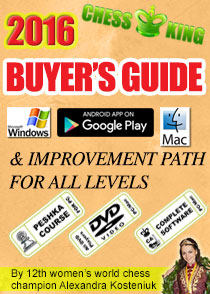








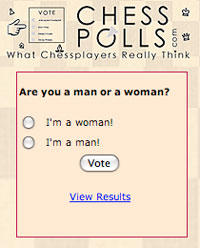
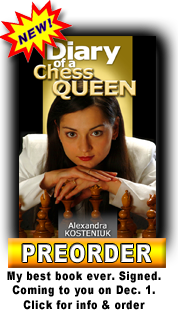










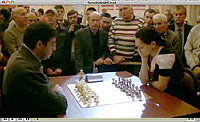
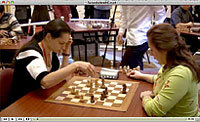
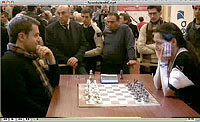
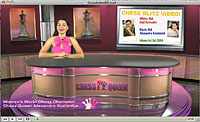
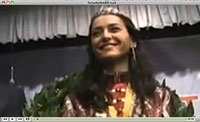

0 Comments:
Post a Comment
Note: Only a member of this blog may post a comment.
Subscribe to Post Comments [Atom]
<< Home